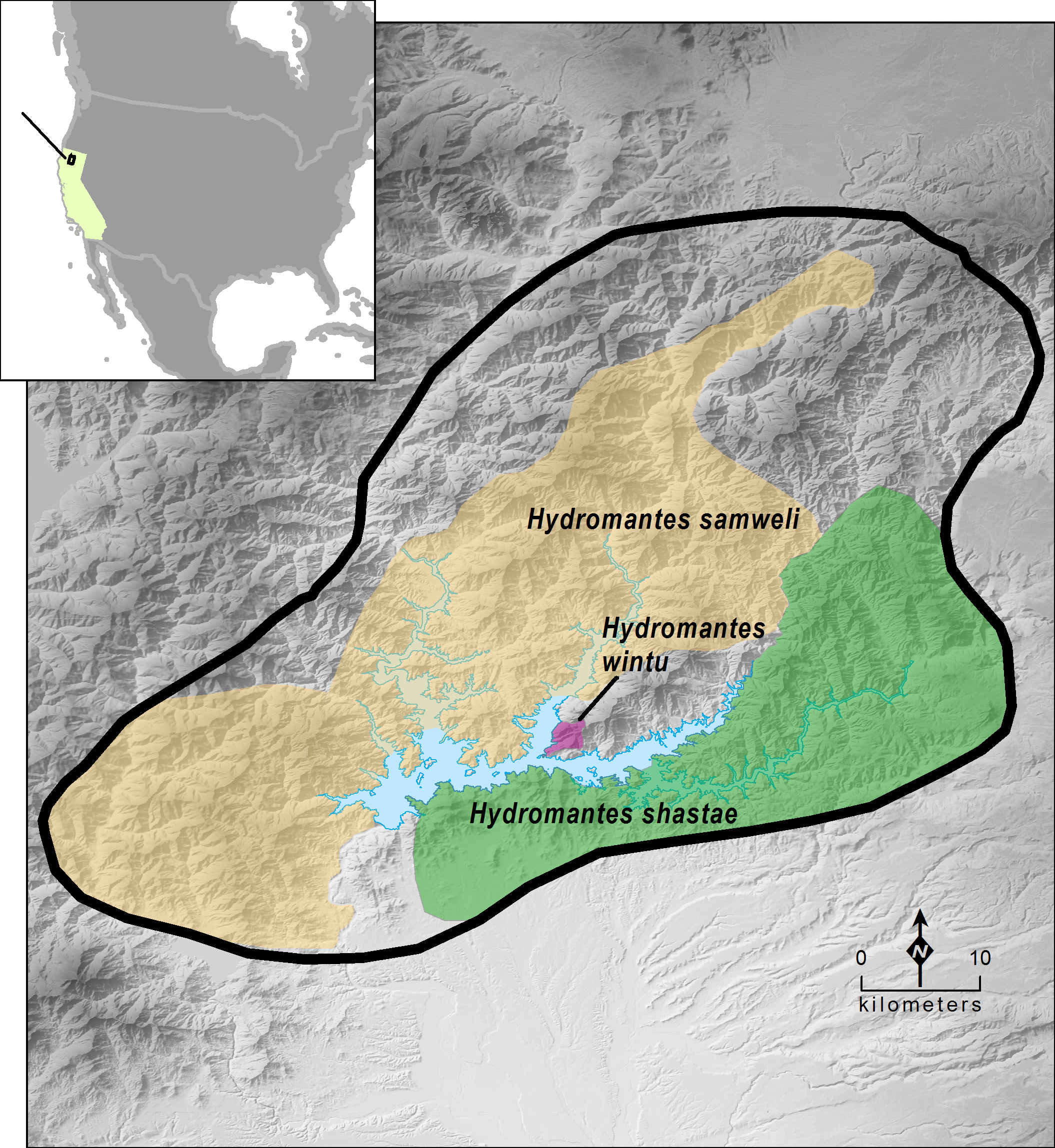|
Hydromantes shastae Gorman & Camp, 1953
Shasta Salamander Subgenus: Hydromantes | family: Plethodontidae subfamily: Plethodontinae genus: Hydromantes |
|
Taxonomic Notes: This species was divided into three species by Bingham et al. 2018 Bulletin of the Museum of Comparative Zoology 161:403-427 (https://mczbase.mcz.harvard.edu/specimen_images/publications/Bulletin_161_10.pdf). See accounts of Hydromantes samweli and Hydromantes wintu. |
|
 © 2011 Len Lindstrand III (1 of 60) |
|
|
|
Description Also like all Hydromantes, the upper teeth of males project outside of mouth and mental gland of males is oval (Stebbins 1985). Tail short (Gorman and Camp 1953). Juveniles resemble adults (Gorman 1956). Distribution and Habitat Country distribution from AmphibiaWeb's database: United States U.S. state distribution from AmphibiaWeb's database: California
With the description of two more species of Hydromantes in its previous range (see H. samweli and H. wintu), Hydromantes shastae is restricted to the south and east of the Shasta Reservoir. To illustrate the distributions of the H. shastae group, the map shows Hydromantes shastae in green, H. samweli in orange, and H. wintu in pink (after Bingham et al 2018); the previous range map for H. shastae is outlined in black. (click image to enlarge) Life History, Abundance, Activity, and Special Behaviors Lays and broods eggs in moist caves during summer (Stebbins 1985). Crawls out in open at night during rains of fall, winter, and spring. Egg clutch size is 9-12. (Hansen and Papenfuss 1994). Hatchlings reach 15-17 mm in snout-vent length. Juveniles are 22-24 mm in snout-vent length and resemble adults (Gorman 1956). Common on surface during moist periods, where it is found mainly under limestone boulders and logs. Lives in caves and is less specialized for climbing than Hydromantes platycephalus (Mount Lyell Salamander). Like all Hydromantes species, the Shasta salamander can shoot its tongue out its mouth 1/3 the length of its body to catch prey (Stebbins 1985). Trends and Threats Relation to Humans Possible reasons for amphibian decline General habitat alteration and loss Comments If held in your hand, the Shasta salamander will cling to your skin with its webbed toes, even if you turn your hand upside-down (J. Romansic, pers. obs.). Along with the Shasta salamander, two other species of Hydromantes are unique to California, while other Hydromantes species inhabit Europe. Hydromantes shastae is named for Mount Shasta, the volcanic mountain that towers over the salamander's range. "Shasta" comes from the name of a Native American, "Sustika", who lived in the area around the year 1840 (Gorman 1964). See another account at californiaherps.com.
References
Bingham, R. E., Papenfuss, T. J., Lindstrand III, L., Wake, D. B. (2018). ''Phylogeography and species boundaries in the Hydromantes shastae complex, with description of two new species (Amphibia: Caudata: Plethodontidae).'' Bulletin of the Museum of Comparative Zoology, 161(10), 403-427. Brodie, E. D., Jr. (1977). "Salamander antipredator postures." Copeia, 1977, 523-535. Dunn, E. R. (1926). ''Hydromantes.'' The Salamanders of the Family Plethodontidae. Smith College, Northhampton, Massachusetts, 344-354. Gorman, J. (1956). ''Reproduction in plethodontid salamanders of the genus Hydromantes.'' Herpetologica, 12, 249-259. Gorman, J. (1964). ''Hydromantes shastae.'' Catalogue of American Amphibians and Reptiles. American Society of Ichthyologists and Herpetologists, 11.1-11.2. Gorman, J. and Camp, C. L. (1953). ''A new cave species of salamander of the genus Hydromantes from California, with notes on habits and habitats.'' Copeia, 1953, 39-43. Hansen, R. W. and Papenfuss, T. J. (1994). ''Shasta Salamander.'' Life on the Edge: A Guide to California's Endangered Natural Resources Volume I: Wildlife. C. G. Thelander, eds., Biosystems Books, Santa Cruz, California., 256-257. Papenfuss, T. and Brouha, P. (1979). The status of the Shasta salamander (Hydromantes shastae): Shasta-Trinity National Forest comprehensive species management plan and a species status report. United States Department of Agriculture Forest Service, Berkeley, California. Petranka, J. W. (1998). Salamanders of the United States and Canada. Smithsonian Institution Press, Washington D.C. and London. Stebbins, R. C. (1985). A Field Guide to Western Reptiles and Amphibians. Houghton Mifflin, Boston. Wake, D. B., Maxon, L. R., and Wurst G. Z. (1978). "Genetic differentiation, albumin evolution, and their biogeographic implications in plethodontid salamanders of California." Evolution, 32(3), 529-539. Originally submitted by: John Romansic (first posted 1999-02-16) Edited by: David B. Wake (Jan 2000), Michelle S. Koo (2022-07-09) Species Account Citation: AmphibiaWeb 2022 Hydromantes shastae: Shasta Salamander <https://amphibiaweb.org/species/4078> University of California, Berkeley, CA, USA. Accessed Apr 16, 2024.
Feedback or comments about this page.
Citation: AmphibiaWeb. 2024. <https://amphibiaweb.org> University of California, Berkeley, CA, USA. Accessed 16 Apr 2024. AmphibiaWeb's policy on data use. |



 Raffaëlli Account
Raffaëlli Account Map of Life
Map of Life